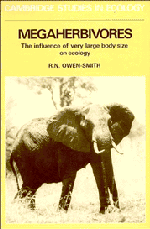Book contents
- Frontmatter
- Contents
- Preface
- 1 Prologue
- 2 Morphology, evolutionary history and recent distribution
- 3 Food and other habitat resources
- 4 Space–time patterns of habitat use
- 5 Body size and nutritional physiology
- 6 Body size and feeding ecology
- 7 Social organization and behavior
- 8 Life history
- 9 Body size and sociobiology
- 10 Body size and reproductive patterns
- 11 Demography
- 12 Community interactions
- 13 Body size and population regulation
- 14 Body size and ecosystem processes
- 15 Late Pleistocene extinctions
- 16 Conservation
- 17 Epilogue: the megaherbivore syndrome
- Appendixes
- References
- Index
9 - Body size and sociobiology
Published online by Cambridge University Press: 01 June 2011
- Frontmatter
- Contents
- Preface
- 1 Prologue
- 2 Morphology, evolutionary history and recent distribution
- 3 Food and other habitat resources
- 4 Space–time patterns of habitat use
- 5 Body size and nutritional physiology
- 6 Body size and feeding ecology
- 7 Social organization and behavior
- 8 Life history
- 9 Body size and sociobiology
- 10 Body size and reproductive patterns
- 11 Demography
- 12 Community interactions
- 13 Body size and population regulation
- 14 Body size and ecosystem processes
- 15 Late Pleistocene extinctions
- 16 Conservation
- 17 Epilogue: the megaherbivore syndrome
- Appendixes
- References
- Index
Summary
Introduction
This chapter considers the effects of large body size on social patterns, in particular (i) group size and structure; (ii) male dominance systems; (iii) female mate choice. Except for group size, these features are not readily characterized in numerical terms, and so cannot be related allometrically to body mass. Instead I will employ a cost/benefit analysis, assessing likely gains and losses in the factors determining evolutionary fitness, i.e. survival chances, reproductive contributions, and offspring survival. An inherent shortcoming of such an approach is that it does not adequately allow for possible interactions between these components (Crook & Goss-Custard 1972; Wilson 1975).
Grouping patterns
Jarman (1974) pointed out that among African bovids group size tends to increase with increasing body size. He explained this pattern in terms of the trade-off between the feeding costs of group formation, and the resultant anti-predation benefits. Because of their high specific metabolic rates, small antelopes are selective feeders on high quality plant parts. These are thinly scattered and quickly depleted. Large ungulates in contrast are relatively fiber-tolerant. They experience a much higher density of acceptable food, which is more uniformly distributed and depleted less by other animals foraging in the same area than is the food of small antelope. Intermediate sized species exhibit a gradient between these extremes. Hence the feeding cost of having close companions decreases with increasing body size.
This explains why large ungulates should be more tolerant of nearby conspecifics while foraging than smaller ungulates, but not why they should actively remain in a group. Jarman thus considered predation risks.
- Type
- Chapter
- Information
- MegaherbivoresThe Influence of Very Large Body Size on Ecology, pp. 160 - 180Publisher: Cambridge University PressPrint publication year: 1988



